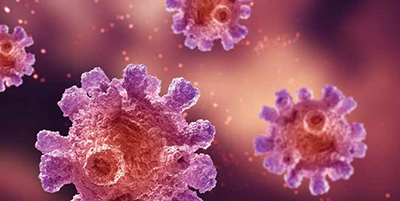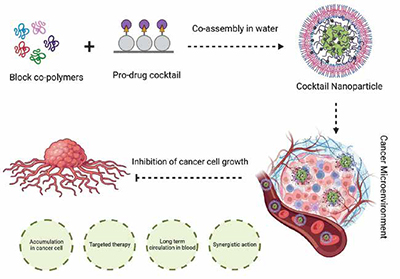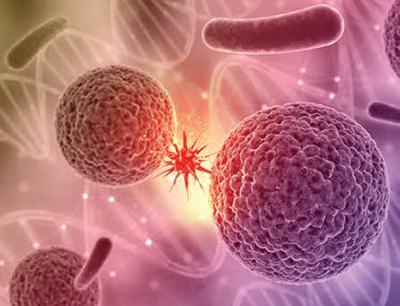Cocktail nanoparticles are a type of nanoparticles that are composed of a mixture of different materials. These nanoparticles have unique properties and are often used in various applications such as drug delivery, imaging, and sensing. The term ‘cocktail’ refers to the combination of different materials in the nanoparticle composition. These materials can be metals, metal oxides, polymers, or organic compounds. By combining different materials, cocktail nanoparticles can exhibit enhanced functionalities and performance compared to single-component nanoparticles in a precise drug delivery system. In drug delivery applications, cocktail nanoparticles can be engineered to carry multiple therapeutic agents simultaneously. This enables the delivery of combination therapies, where different drugs are released at specific locations and time points, enhancing treatment efficiency and reducing side effects.

Cocktail nanoparticles are also valuable in imaging applications, such as in cancer diagnosis and monitoring. By incorporating different contrast agents, these nanoparticles can provide multi-modal imaging capabilities, allowing for more accurate and comprehensive imaging of tissues and organs. One major advantage of using cocktail nanoparticles is the ability to fine-tune their properties. By adjusting the composition and ratio of the different materials, researchers can tailor the nanoparticles' size, shape, surface chemistry, and optical properties to meet specific application requirements. This versatility allows for the design of nanoparticles with improved stability, biocompatibility, and targeting capabilities. These tiny particles hold immense potential in providing targeted and effective treatments for cancer patients. By combining different types of nanoparticles, researchers are able to create a ‘cocktail’ that can simultaneously target multiple aspects of cancer cells, enhancing the overall effectiveness of treatment. Each nanoparticle within the cocktail can perform a specific function, such as delivering drugs directly to the tumour, enhancing immune response, or inhibiting cancer cell growth. By combining these different functionalities into one treatment approach, researchers hope to overcome some of the challenges of traditional cancer therapies, such as drug resistance and off-target effects. Cocktail nanoparticles hold immense potential in revolutionising cancer therapy. By combining different types of nanoparticles into one treatment approach, researchers can enhance the effectiveness of cancer treatment and overcome some of the limitations of traditional therapies.
Cocktail nanoparticles work by combining the strengths of different nanoparticles into one treatment approach. Each nanoparticle within the cocktail is designed to perform a specific function, such as targeting the tumour, delivering drugs, or enhancing immune response. By simultaneously targeting multiple aspects of cancer cells, cocktail nanoparticles have the potential to increase treatment efficacy and overcome some of the limitations of traditional cancer therapies. They can attack cancer cells from different angles, making it harder for the cells to develop resistance or evade treatment. In a study, cocktail nanoparticles were used to enhance the effectiveness of immunotherapy, a type of cancer treatment that harnesses the body's immune system to fight cancer. By combining nanoparticles that enhance immune response with nanoparticles that deliver immunotherapeutic agents, researchers were able to significantly improve the response rate and overall survival of cancer patients.

The versatility of cocktail nanoparticles allows for the synergistic action of different therapeutic agents, increasing the chances of successfully eliminating cancer cells and improving patient outcomes. One of the primary advantages of using cocktail nanoparticles is their ability to target multiple aspects of cancer cells simultaneously. Cancer is a complex disease, and it often requires a multi-faceted approach to effectively treat it. Cocktail nanoparticles allow for the synergistic action of different therapeutic agents, increasing the chances of successfully eliminating cancer cells and preventing relapse. Furthermore, cocktail nanoparticles can be functionalized with various ligands or antibodies on their surfaces, enabling targeted delivery to specific cells or tissues. This targeted approach increases drug efficacy and reduces off-target effects. While cocktail nanoparticles offer great promise in cancer therapy, there are several challenges and limitations that need to be addressed. One challenge is the complexity of designing and synthesising nanoparticles with multiple functionalities. Each nanoparticle within the cocktail must be carefully engineered to perform its specific function while maintaining compatibility with the other nanoparticles. Another challenge is the potential for off-target effects. Since cocktail nanoparticles are designed to target multiple aspects of cancer cells, there is a risk of affecting healthy cells or tissues. Researchers need to ensure that the nanoparticles deliver their cargo precisely to the tumour site and minimise any potential damage to healthy cells. Furthermore, the longterm safety and toxicity of cocktail nanoparticles need to be thoroughly evaluated. While nanoparticles have shown great potential in cancer therapy, their impact on the body's organs and immune system is still not fully understood. It is crucial to conduct rigorous preclinical and clinical studies to ensure the safety and effectiveness of cocktail nanoparticle therapy.

Despite the challenges, the future of cocktail nanoparticle therapy looks promising. Researchers are continuously exploring new ways to improve the design and functionality of nanoparticles, making them more effective and safer for cancer treatment. Advances in nanotechnology and material science are opening up new possibilities for creating nanoparticles with enhanced targeting abilities and controlled drug release properties. The use of cocktail nanoparticles in cancer therapy is still in its early stages, but there are already promising case studies and success stories that highlight their potential. For example, researchers have successfully used cocktail nanoparticles to deliver multiple chemotherapy drugs directly to the tumour site, resulting in improved treatment outcomes and reduced side effects. Moreover, the field of personalised medicine is expected to greatly benefit from cocktail nanoparticles. As our understanding of cancer biology improves, researchers will be able to tailor the composition of the cocktail to match the specific characteristics of each patient's cancer, maximising treatment efficacy and minimising side effects. In addition, advancements in imaging technologies will play a crucial role in the development of cocktail nanoparticle therapy. By combining nanoparticles with imaging agents, researchers can track the distribution of the nanoparticles in real-time, ensuring that they reach their intended targets and monitor the treatment response.
The use of cocktail nanoparticles in cancer treatment raises important ethical considerations. As with any new therapy, it is crucial to ensure that the benefits outweigh the potential risks and that patient autonomy is respected. Patients should have access to accurate information about the treatment, including its potential benefits, risks, and alternatives. In summary, cocktail nanoparticles offer a versatile and customisable platform for various applications, allowing researchers to explore new possibilities in nanomedicine, imaging, and sensing. Their unique combination of properties makes them a promising tool in advancing healthcare and diagnostics. Moreover, cocktail nanoparticles offer the potential to personalise cancer treatment. Researchers can tailor the composition of the cocktail based on the specific characteristics of the patient's cancer, ensuring a more targeted and effective therapy. This personalised approach has the potential to revolutionise cancer treatment and improve patient outcomes. With continued advancements in nanotechnology and personalised medicine, cocktail nanoparticles have the potential to transform the landscape of cancer treatment, offering new hope to patients and their families.